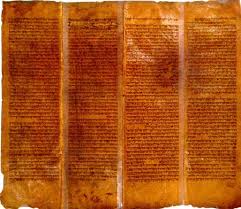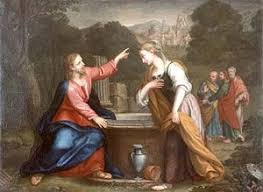பழைய ஏற்பாடு எனப்படும், யூத மதப் புராணக் கதைகள் கொண்ட புத்தகம், எபிரேய மொழ்யில் வரையப்பட்டவை. இதில் முதல் 5 புத்தகங்கள் சட்டங்கள் எனப்படும், இவற்றின் கதாசிரியர் மோசே எனப்படும். ஏசுவின் காலத்திற்கு 200 ஆண்டுகள் முன்பு கிரேக்க காலத்தில் புனையப் பட்டவை எனப் பார்த்தோம்.


பழைய ஏற்பாடு - நியாயப் பிரமாணங்கள் உருவான கதை.
எபிரேய மொழியில், உயிர் எழுத்துக்கள், ஏசுவிற்கு 800 ஆண்டு பின்பு தான் உருவாயிற்று, உயிர் எழுத்து சேர்த்து எழுதப்பட்ட மெசொடரிக் 9ம் நூற்றான்டு ஏடு தான் நம்ம்பிடம் உள்ள எபிரேய பழைய ஏற்பாடு ஏடுகள். சில கிரேக்க, கத்தோலிக்க லத்தீன் ஏடுகள் முந்தைய காலத்தியது உண்டு. மேலும் சமாரியர் யூதரிடம் பிரிந்து, முதல் 5 புத்தகம் மட்டும் கொண்ட சமாரிய பைபிளும் உண்டு. இன்னிலையில் சவக்கடல் சுருள்கள் எனும் பொ.மு.1ம் - பொ.கா. 1ம் நூற்றாண்டு ஏடுகள் கிடைத்தன.
சமாரிய பழைய ஏற்பாடு பல இடங்களில் யூத பைபிளி இருந்து மாறுபட்டது. இதன் காலமும் ஆய்வுக்கு உரியதே. இப்போது பைபிளியல் ஆய்வாளர்கள் சமாரியர் பிர்ந்தது பொ.மு. 122 வாக்கில் என ஏஎற்கின்றனர். ஏசுவிற்கு 120 ஆண்டு முன் சமாரியப் பிரிவு வந்தது, அப்போது நியாயப் பிரமாணம் மட்டுமே இருக்க அதை மட்டுமே சமாரியர் ஏற்பர்.
Recent scholarship, however, is inclined to think that Recent scholarship, however, is inclined to think that the real schism between the peoples did not take place until Hasmonean times when the Gerizim temple was destroyed in 128 B.C. The script of the Samaritan Pentateuch, its close connections at many points with the Septuagint, and its even closer agreements with our present Hebrew text, all suggest a date about 122 B.C.
மோசே பெற்றதான 10 கற்பனைகள் கூட திருத்தப்பட்டு சூழ்ச்சிகள் உள்ளன.
Among the most notable semantic variations reflecting deliberate scribal intention are those related to the Samaritan place of worship on Mount Gerizim. The Samaritan version of the Ten Commandments commands that an altar be built on Mount Gerizim on which all sacrifices should be offered.[18][19] The Samaritan version contains the additional text at Exodus 20:17:
- "And when it so happens that LORD God brings you to the land of Canaan, which you are coming to possess, you shall set up there for you great stones and plaster them with plaster and you write on the stones all words of this law. And it becomes for you that across the Jordan you shall raise these stones, which I command you today, in mountain Gerizim. And you build there the altar to the LORD God of you. Altar of stones. Not you shall wave on them iron. With whole stones you shall build the altar to LORD God of you. And you bring on it ascend offerings to LORD God of you, and you sacrifice peace offerings, and you eat there and you rejoice before the face of the LORD God of you. The mountain this is across the Jordan behind the way of the rising of the sun, in the land of Canaan who is dwelling in the desert before the Galgal, beside Alvin-Mara, before Sechem."[20]
This commandment is absent from the corresponding text of the Ten Commandments in the Masoretic. The Samaritan Pentateuch's inclusion of the Gerizim variation within the Ten Commandments places additional emphasis on the divine sanction given to that community's place of worship.[2] This variation has similarities to Deuteronomy 27:2-8 and is supported by changes to the verbal tense within the Samaritan text of Deuteronomy indicating that God has already chosen this place. The future tense ("will choose") is used in the Masoretic.[2] And whereas Deuteronomy 27:4 in the Masoretic commands an altar to be constructed on Mount Ebal, the Samaritan texts has Mount Gerizim.
A Samaritan village (Kiryat Luza) and an Israeli settlement (Har Bracha) are situated on the mountain ridge.
The mountain is sacred to the Samaritans who regard it, rather than Jerusalem'sTemple Mount, as having been the location chosen by Yahweh for a holy temple. The mountain continues to be the centre of Samaritan religion to this day, and over 90% of the worldwide population of Samaritans live in very close proximity to Gerizim, mostly in Kiryat Luza, the main village. The passover is celebrated by the Samaritans on Mount Gerizim,[3] and it is additionally considered by them as the location of the near-sacrifice of Isaac (the masoretic, Septuagint and the Dead Sea Scroll versions of Genesis state that this happened on Mount Moriah which Jews traditionally identify as the Temple Mount).[2] According to classical rabbinical sources, in order to convert to Judaism, a Samaritan must first and foremost renounce any belief in the sanctity of Mount Gerizim.[2]
Comparison with the Septuagint and Latin Vulgate[edit]
The Septuagint (LXX) agrees with the Samaritan in approximately 1900 of the six thousand variations from the Masoretic.[13]Many of these agreements reflect inconsequential grammatical details, but some are significant. For example, Exodus 12:40 in the Samaritan and the LXX reads:[23]
- "Now the sojourning of the children of Israel and of their fathers which they had dwelt in the land of Canaan and in Egyptwas four hundred and thirty years."
In the Masoretic text, the passage reads:
- "Now the sojourning of the children of Israel, who dwelt in Egypt, was four hundred and thirty years."
Some passages in the Latin Vulgate show agreements with the Samaritan against the Masoretic. For example, Genesis 22:2 in the Samaritan has "land of Moreh" (Hebrew: מוראה) while the Masoretic has "land of Moriah" (Hebrew: מריה). "Land of Moreh" is considered to be a Samaritan variant because "Moreh" describes the region around Shechem,[24] where Mount Gerizim is situated. The Vulgate translates this phrase as in terram visionis ("in the land of vision") which implies that Jeromewas familiar with the reading "Moreh", a Hebrew word whose consonants suggest "vision."[25]
மான்செஸ்டர் பழ்கலைக்கழகத்தில் பைபிளியல் விமர்சனம் மற்றும் விவாதத்திற்கான ரைல்ண்ட்ஸ் பேராசிரியராக இருந்த, காலம் சென்ற பேராசிரியர் F F புரூஸ் அவர்கள் "The Real Jesus" என்ற தன் நூலில்
"The Conclusion usually (and I thingk rightyly) drawn from their Comparitive Study is that the Gospel of Mark (or something very like it) served as the source for the Gospels of Mattwhew and Luke, and that these two also had access to a collection of sayings of Jesus (Convenientily called 'Q')....."
சுவிசேஷங்களை ஒன்று இணைத்துப் பார்க்கும் பைபிள் அறிஞர்கள் பெரும்பாலும் ஒருமுகமாக மாற்கு சுவி(அல்லது அது போல ஒன்று)அடிப்படையைக் கொண்டு மத்தேயூ லூக்கா சுவிகள் எழுதப்பட்டன, மேலும் ஏசு சோன்னவை என ஒரு செவி வழி தொகுப்பையும் சேர்த்து இவ்விரு சுவிகள் வந்தன.
மாற்கு சுவியில் ஏசு பிறப்பு அதிசயம் கிடையாது. ஏசுவிற்கு சகோதர சோகதரிகள் உண்டு.
If we had only Mark's Gospel we should infer that Jesus ministry was located in Galilee with one first and final visit to Jerusalem, and that the Galilean ministry began after John the Baptist was imprisoned.
The IVth Gospel takes a different view. Here the scene shifts backwards and forwards between Galilee and Judea during the first 6 chapters. From Chapter-7 onwards the scene is laid wholly in Judea and Jerusalem. Moreover, St.John explicitly states that Jesus was active in Judea and Jerusalem before the Baptist was imprisoned, for John was not yet cast in Prison (Jn 3:24)
Page-45, Words and Works of Jesus, A.M.Hunter.
மாற்கு ஏசு இயங்கிய காலம் முழுதும் கலிலெயாவில் என்றும், பாவமன்னிப்பு ஞானஸ்நானம் பெறவும், கடைசி ஒருவார்ம் மட்டும் யூதேயாவில் என மாற்கு சொல்லியுள்ளார். நான்காவது சுவிசேஷத்தில், காட்சி கலிலெயா - யூதேயா என மாற்றி மாற்றி முதல் 6 அத்தியாயங்களும், 7ம் அத்தியாயத்திலுருந்து முழுதும் யூதேயாவில்- ஜெருசலேமில் என்கிறார். ஞானஸ்நான யோவான் கைதிற்கு முன்பே ஏசு சீடர் சேர்த்து இயங்கினார் எனவும் காட்டுகிறது.-என பைபிளியல் அறிஞர் ஹன்டர் உறிதியாய் சொல்கிறார்.
ஏசு ஜெருசலேம் சென்றது, அங்கே எபிரேயர் சிறு எல்லை தெய்வம் ஆலயம் என, ஆனால் மூல பைபிளில் அது கெர்சிம் மலையில் என உள்ளது, என சமாரியத் டோராவும், சாக்கடல் சுருள்களும் சொல்கிறது. ஆனால் நம்மிடம் தரப்படும் பைபிளில், ஆதி 22:2, நான் பின்பு கூறும் மலையில் என மோசடியாய் திரிக்கிறது
ஆதியாகமம்22: 1 இந்நிகழ்ச்சிகளுக்குப் பின், கடவுள் ஆபிரகாமைச் சோதித்தார். அவர் அவரை நோக்கி, ஆபிரகாம்! என, அவரும் 'இதோ! அடியேன்' என்றார். 2 அவர், ″உன் மகனை, நீ அன்பு கூரும் உன் ஒரே மகனான ஈசாக்கை அழைத்துக் கொண்டு, மோரியா நிலப்பகுதிக்குச் செல். அங்கு நான் உனக்குக் காட்டும் மலைகளில் ஒன்றின் மேல் எரி பலியாக அவனை நீ பலியிடவேண்டும்″ என்றார்.
2 அவர், ″உன் மகனை, நீ அன்பு கூரும் உன் ஒரே மகனான ஈசாக்கை அழைத்துக் கொண்டு, மோரியா நிலப்பகுதிக்குச் செல். அங்கு நான் உனக்குக் காட்டும் மலைகளில் ஒன்றின் மேல் எரி பலியாக அவனை நீ பலியிடவேண்டும்″ என்றார்.
:உபாகமம் 11:29 “உங்களின் சுதந்திர தேசத்தில் உங்கள் தேவனாகிய கர்த்தர் உங்களை வழிநடத்திச் செல்வார். நீங்கள் விரைவில் அந்த தேசத்தில் வாழ்ப்போகிறீர்கள். அந்த நேரத்தில் கெரிசீம் மலையின் உச்சிக்கு நீங்கள் செல்ல வேண்டும். அங்கிருந்து ஜனங்களுக்கு ஆசீர்வாதங்களைக் கூறுங்கள். பின்பு ஏபால் மலையின் உச்சிக்குச் செல்லவேண்டும். அங்கிருந்து ஜனங்களுக்கு சாபங்களைக் கூற வேண்டும்.

 யோவான்4: 4கலிலேயாவுக்கு அவர் சமாரியா வழியாகச் செல்லவேண்டியிருந்தது.5அவர் சமாரியாவில் உள்ள சிக்கார் என்னும் ஊருக்கு வந்து சேர்ந்தார். யாக்கோபு தம் மகன் யோசேப்புக்குக் கொடுத்த நிலத்துக்கு அருகே அந்த ஊர் இருந்தது.6அவ்வூரில் யாக்கோபின் கிணறும் இருந்தது. பயணத்தால் களைப்புற்றிருந்த இயேசு கிணற்று ஓரமாய் அமர்ந்தார்.
20 எங்கள் முன்னோர் இம்மலையில் வழிபட்டுவந்தனர். ஆனால் நீங்கள் எருசலேமில்தான் வழிபட வேண்டும் என்கிறீர்களே ' என்றார்.
யோவான்4: 4கலிலேயாவுக்கு அவர் சமாரியா வழியாகச் செல்லவேண்டியிருந்தது.5அவர் சமாரியாவில் உள்ள சிக்கார் என்னும் ஊருக்கு வந்து சேர்ந்தார். யாக்கோபு தம் மகன் யோசேப்புக்குக் கொடுத்த நிலத்துக்கு அருகே அந்த ஊர் இருந்தது.6அவ்வூரில் யாக்கோபின் கிணறும் இருந்தது. பயணத்தால் களைப்புற்றிருந்த இயேசு கிணற்று ஓரமாய் அமர்ந்தார்.
20 எங்கள் முன்னோர் இம்மலையில் வழிபட்டுவந்தனர். ஆனால் நீங்கள் எருசலேமில்தான் வழிபட வேண்டும் என்கிறீர்களே ' என்றார்.
If we had only Mark's Gospel we should infer that Jesus ministry was located in Galilee with one first and final visit to Jerusalem, and that the Galilean ministry began after John the Baptist was imprisoned.
Page-45, Words and Works of Jesus, A.M.Hunter.
மாற்கு ஏசு இயங்கிய காலம் முழுதும் கலிலெயாவில் என்றும், பாவமன்னிப்பு ஞானஸ்நானம் பெறவும், கடைசி ஒருவார்ம் மட்டும் யூதேயாவில் என மாற்கு சொல்லியுள்ளார். நான்காவது சுவிசேஷத்தில், காட்சி கலிலெயா - யூதேயா என மாற்றி மாற்றி முதல் 6 அத்தியாயங்களும், 7ம் அத்தியாயத்திலுருந்து முழுதும் யூதேயாவில்- ஜெருசலேமில் என்கிறார். ஞானஸ்நான யோவான் கைதிற்கு முன்பே ஏசு சீடர் சேர்த்து இயங்கினார் எனவும் காட்டுகிறது.-என பைபிளியல் அறிஞர் ஹன்டர் உறிதியாய் சொல்கிறார்.:உபாகமம் 11:29 “உங்களின் சுதந்திர தேசத்தில் உங்கள் தேவனாகிய கர்த்தர் உங்களை வழிநடத்திச் செல்வார். நீங்கள் விரைவில் அந்த தேசத்தில் வாழ்ப்போகிறீர்கள். அந்த நேரத்தில் கெரிசீம் மலையின் உச்சிக்கு நீங்கள் செல்ல வேண்டும். அங்கிருந்து ஜனங்களுக்கு ஆசீர்வாதங்களைக் கூறுங்கள். பின்பு ஏபால் மலையின் உச்சிக்குச் செல்லவேண்டும். அங்கிருந்து ஜனங்களுக்கு சாபங்களைக் கூற வேண்டும்.


http://genealogyreligion.net/tag/solomons-temple
ReplyDeletehttp://www.netours.com/content/view/91/1/
ReplyDeletehttp://www.spiegel.de/international/world/new-research-shows-that-jerusalem-may-not-be-the-first-temple-a-827144-2.html
ReplyDeleteநண்பரெ- அதிசய பொய் சமயத்தாரே,
ReplyDeleteவிக்கியினைக் கொண்டு சொல்லும் நீரே,
நாம் கூறியுள்ளதும் அதைக் கொண்டு தான், மேலும் பல பல்கலைக் கழக ஆய்வுகளோடு சரிபார்த்தபின் தான் பதித்துள்ளோம்
முழுமையாய் பைபிளைக் கொண்டும், இஸ்ரேலின் புதைபொருள் ஆய்வுகள், கிறிஸ்துவர்களின் ஆய்வு முடிவுகள் கொண்டு தான் விளக்கப்பட்டுள்ளது,
நீங்கள் கொடுத்த விக்கியின், சாலமன் ஆலயப் பக்கம் சொல்வதை படியுங்கள்.
http://en.wikipedia.org/wiki/Solomon's_Temple
There is no direct archaeological evidence for the existence of Solomon's Temple. This building is not mentioned in surviving extra-biblical accounts.
தாவீது- சாலமன் காலத்தில் ஜெருசலேம் ஒரு சின்னஞ்சிறு கிராமம்.
ஆபிரகாம், மோசே, தாவீது - சாலமன் எல்லாமே கட்டுக்கதை நாயகர்கள். பிற்கால பைபிள் புனையல கதைகள் தவிர அந்த பக்கத்து நாடுகள் உட்பட எந்த இடத்திலும் இவை சொல்லப்படவில்லை.
யூதர்கள் அரபிய எனமே.
மேற்கத்திய நாடுகள், பல்கலை கழகங்கள் எல்லாமே கிறிஸ்துவ கட்டுப்பாடினால் தவிக்கிறது. ஏசு பற்றி யோசிபஸ் மற்றும் ரோமன் குறிப்புகள் அனைத்துமே போர்ஜரி என நடுநிலை கிறித்தவர் ஏற்க, பழமைவாத கட்டுபாட்டால் விக்கி அவற்றை நம்பலாம் என விக்கியுலும், ஏசு பற்றியவை எல்லாமெ போர்ஜரி என பகுத்தறிவு விக்கியிலும் பதிக்கிறது. இன்னௌம் சர்ச் கத்தி பலம் கொண்டுள்ளது.
சாக்கடல் சுருள்கள் கிடைத்து 40 ஆண்டுகள் ஆர்சி சர்ச் கட்டுப்பாட்டுக்குள் வந்து, பின் சில தொந்தரவினால் வெளியானதே தவிர, அவற்றின் நம்பிக்கைதனமை 100% அல்ல.
புதைபொருள் அகழ்வும், பைபிள் வசனங்களும் சொல்லத எவற்றையும் நீங்கள் தந்த் பக்கம் விளக்க வில்லை. கின் ஆர்பன் 14 சோதனையில் ஒவ்வொரு முறையும் மாறுபட்டது என்பது பலதை விளக்கும். நாம் சாக்கடல் சுருள்களின் அடிப்படையில் பைபிளின் சிறு அருவெறுப்பு தெய்வம் கர்த்தர் ஜெருசலேமை தேர்ந்தெடுக்கவே இல்லை.
http://pagadhu.blogspot.in/2014/05/blog-post_2846.html
http://en.wikipedia.org/wiki/Dead_Sea_Scrolls
ReplyDeleteThe texts are written in Hebrew, Aramaic, Greek, and Nabataean, mostly on parchment but with some written on papyrus and bronze.[4] The manuscripts have been dated to various ranges between 408 BCE and 318 CE.[5] Bronze coins found on the site form a series beginning with John Hyrcanus (135–104 BCE) and continuing until the First Jewish-Roman War (66–73 CE).
ஏசையா என்னும் கதையின் தீர்க்கர் புத்தகம் ஆரம்பம் பொ.மு. 8ம் நூற்றாண்டின் தொடங்கி முடிவில் 5ம் நூற்றாண்டு வரை நீழ்கிறது, பல கிரேக்க சொற்கள் கொண்டது. பைபிளியலார் 3 ஏசையாக்கள் என இதற்கு மழுப்பல் சால்ஜாப்பு விடுவர்.
எசாயா36, 37, 38:1-8 -இவை அப்படியே 2இராஜாக்கள்18:13- 37, 19, 20 - 11 உள்ளவை, வார்த்தைக்கு வார்த்தை கட் பேஸ்ட் முறையில் உள்ளது,
பின்னதன் காலம் ஏசையாவிற்கு 4 நூறாண்டு பின்னர் தான்-
பைபிள் பழைய ஏற்பாடு- புதிய ஏற்பாடு வெற்று அரசியல் சூழ்ச்சிகள் என்பது பைபிளை நடுநிலையோடு படிப்பவர் அனைவரும் உணரலாம்.